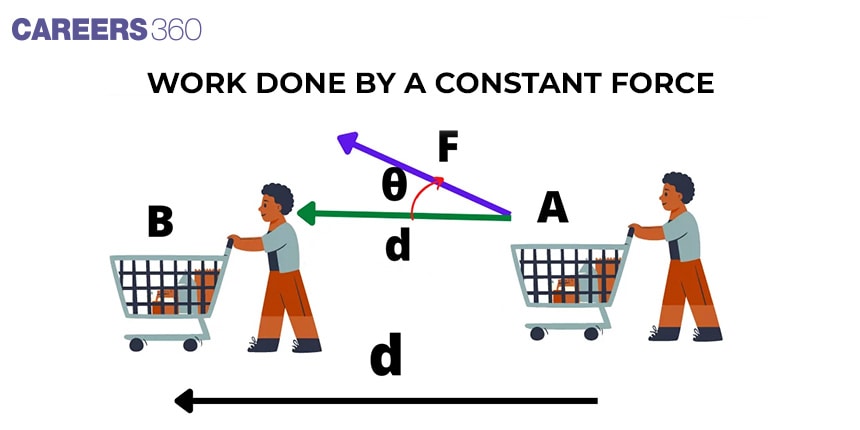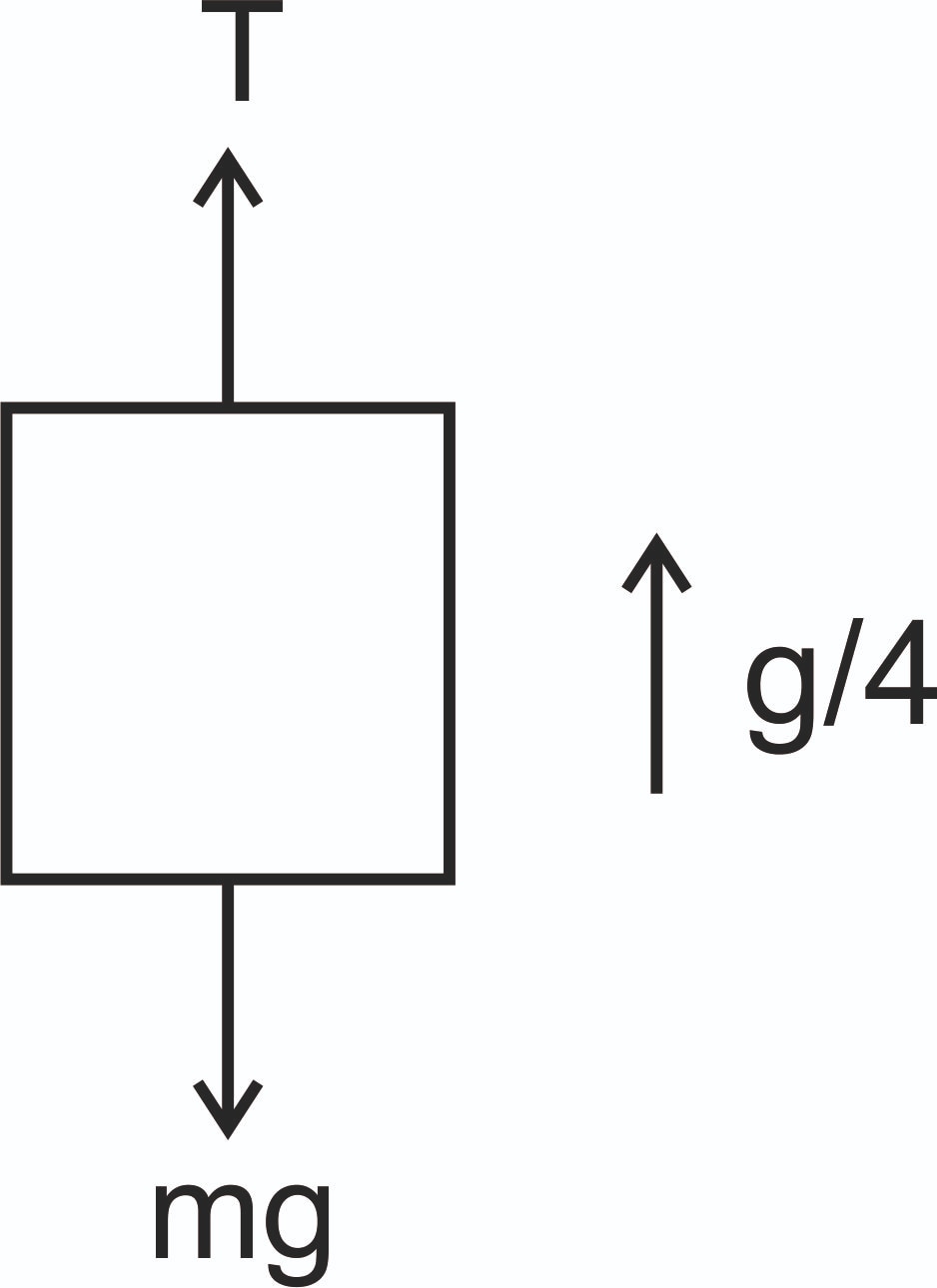Work Done By A Constant Force
Work is considered to be done when a force operating on a body can really move it a certain distance in the direction of the force. The watchman at the office gate is not causing any load to move and is simply standing there, thus both force and displacement are zero. Similarly, no work is done by the watchman. When the coolie bears a load on his head, he applies vertical effort to support it. With the load on his head, the coolie moves horizontally along the platform. Since no distance is covered along the vertical, that is, in the direction of the force exerted by him, the work performed by the coolie is also zero.
JEE Main/NEET 2027: Physics Important Formulas for Class 10
NEET 2025: Mock Test Series | Syllabus | High Scoring Topics | PYQs
JEE Main: Study Materials | High Scoring Topics | Preparation Guide
JEE Main: Syllabus | Sample Papers | Mock Tests | PYQs
- Define Work
- Dependence Of Work Done By A Constant Force
- Types of Work
- Solved Examples Based on Work Done By a Constant Force
- Summary

In this article, we will cover the concept of work and its types, including work done by a constant force. This concept falls under the broader category of work, energy, and power, which is a crucial chapter in Class 11 physics. It is not only essential for board exams but also for competitive exams like the Joint Entrance Examination (JEE Main), National Eligibility Entrance Test (NEET), and other entrance exams such as SRMJEE, BITSAT, WBJEE, BCECE and more. Over the last ten years of the JEE Main exam (from 2013 to 2023), a total of six questions have been asked on this concept, including two in 2019, one in 2020, two in 2021, and one in 2023. And for NEET two questions were asked from this concept.
Let's read this entire article to gain an in-depth understanding of the work done by a constant force.
Define Work
Work is said to be done when a force applied on the body displaces the body through a certain distance along the direction of the force.
Work Done By a Constant Force
1. The scalar product of the force vector
2. The product of the magnitude of force
3. If the number of forces
4. Units-
SI Unit-Joule
CGS Unit- Erg
1 Joule
5. Dimension-
1. The scalar product of the force vector
2. The product of the magnitude of force
3. If the number of forces
Then
4. Units-
- SI Unit-Joule
- CGS Unit- Erg
- 1 Joule
5. Dimension-
Dependence Of Work Done By A Constant Force
Till now we have studied the work and work done by a constant force now we are going to study the dependence of work done by a constant force, in which mainly covers the frame of reference.
- Frame of reference: With a change of frame of reference (inertial), force does not change while displacement may change. So the work done by a force will be different in different frames. i.e. A person is pushing a box inside a moving train with a force
Then work done by
Types of Work
There are mainly three types of work which are mentioned below:
- Positive Work-
- Positive work means that force (or its component) is parallel to displacement.
- Means
Where
- Maximum work
- E.g When you move a block by pulling it then work done by you on the block is positive
- Negative Work
- Negative work means that force (or its component) is opposite to displacement.
- Means
Where is the angle between force vectors and displacement vector
- Minimum work=
- E.g When a body is made to slide over a rough surface, the work done by the frictional force is negative
- Zero work
- Under three conditions Work can be zero
a. If the force is perpendicular to the displacement
Means
E.g-When a body moves in a circle the work done by the centripetal force is always zero.
b. If there is no displacement (means s = 0)
E.g- When a person tries to displace a wall by applying a force and can't able to move the wall
So the work done by the person on the wall is zero.
c. If there is no force acting on the body (means F=0)
E.g- Motion of an isolated body in free space.
Solved Examples Based on Work Done By a Constant Force
Example 1: A force
- 8
- 10
- 15
- 6
The scalar product of the force vector
Hence, the answer is the option (4).
Example 2: A particle is acted upon by a force of constant magnitude which is always perpendicular to the velocity of the particle, the motion of the particle takes place in a plane. It follows that :
- its velocity is constant
- its acceleration is constant
- its kinetic energy is constant (correct)
- it moves in a straight line.
Solution:
Net work done by all the forces gives the change in kinetic energy -
- wherein
As
In this case, since force is constant and it is always perpendicular to velocity, the work done by this force is zero. Hence kinetic energy remains constant.
Hence, the correct answer is option(3)
Example 3: A block of mass m is kept on a platform which starts from rest with constant acceleration g/2 upward, as shown in the figure. Work done by the normal reaction on the block in time t is:
1.
2.
3. 0
4)
Solution:
The scalar product of the force vector
By balancing the forces in the vertical direction, we get:
and displacement is given by the equation:
where
and we know,
Example 4: A particle which is experiencing a force, given by
- 10
- 9
- 15
- 12
Solution:
Net work done by all the forces gives the change in kinetic energy -
Hence, the answer is the option (3).
Example 5: A lift of mass m is moving in an upward direction with acceleration g/4 , its displacement is 'h'. Find out work (in mgh) done by the tension force
1) 0.25
2) 1.25
3) 2
4) 0.75
Solution:

![]()
Hence, the answer is option (2).
Summary
If nothing is actually moving, no work is done- no matter how great the force is involved. Work is a scalar quantity but you can have positive and negative work. positive work is where the force pulls in the same direction as the movement. Negative work is where the force is in the opposite direction. This is the very first concept of work energy and power after this we generally study the Work Done By Variable Force.
Also Read
28 Nov'24 02:56 PM
22 Nov'24 07:42 AM
21 Nov'24 04:30 PM
21 Nov'24 02:19 PM
20 Nov'24 07:40 PM
14 Nov'24 04:18 PM
12 Nov'24 10:07 PM
12 Nov'24 09:16 PM
26 Sep'24 10:49 AM